I’ve recently got an iPhone, and I’m quite impressed at how good the camera is. On Twitter, a group of self-proclaimed ‘watchnerds’ has begun posting daily wrist shots under the hashtag ‘womw’ (what’s on my wrist) — see http://search.twitter.com/search?q=womw
Here are a few of my casual iPhone WOMW shots:
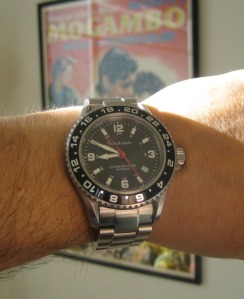 Bernhardt Globemaster GMT. This is a modern watch ‘inspired’ by the Rolex GMT Master, albeit more on the scale of a Seadweller/Deepsea at 42mm diameter and very thick. It uses a modified ETA automatic movement to provide a separately adjustable 24-hour hand. Along with a rotating 24-hour bezel, it’s easy to read three different timezones at a glance (I currently have it set to show local time on the main hands, GMT/UTC with the red 24-hour hand and New York time on the outer bezel). It’s 200-metre waterproof with a screw-down crown, and has a sapphire crystal. Made in limited editions by Fred Amos in the US using Swiss movements and German-made cases, Bernhardt is one of the many bespoke watch brands popping up that only operate online and which draw their custom from the keen watch fans who frequent internet forums. This is one of my favourite ‘everyday’ watches, at home on a NATO or stitched brown leather strap as well as on its very well made, solid-end-link oyster bracelet. (see http://www.bernhardtwatch.com/globemaster.html )
Bernhardt Globemaster GMT. This is a modern watch ‘inspired’ by the Rolex GMT Master, albeit more on the scale of a Seadweller/Deepsea at 42mm diameter and very thick. It uses a modified ETA automatic movement to provide a separately adjustable 24-hour hand. Along with a rotating 24-hour bezel, it’s easy to read three different timezones at a glance (I currently have it set to show local time on the main hands, GMT/UTC with the red 24-hour hand and New York time on the outer bezel). It’s 200-metre waterproof with a screw-down crown, and has a sapphire crystal. Made in limited editions by Fred Amos in the US using Swiss movements and German-made cases, Bernhardt is one of the many bespoke watch brands popping up that only operate online and which draw their custom from the keen watch fans who frequent internet forums. This is one of my favourite ‘everyday’ watches, at home on a NATO or stitched brown leather strap as well as on its very well made, solid-end-link oyster bracelet. (see http://www.bernhardtwatch.com/globemaster.html )
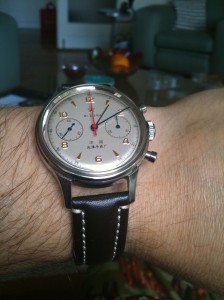 This is a Chinese-made Seagull 1963 chronograph. There is quite an interesting story behind these: in the 1950s, China saw what the Russians were doing with watchmaking (brands such as Poljot and Vostok) and while they’d been making basic, reasonable quality watches for some time, the Mao government wanted a flagship watch. Enter the Swiss movement company Venus, who made wonderful chronographs in the 1930s and 40s using a column-wheel: they needed capital to develop new technologies, so they sold the machinery and patents for their classic 175 chrono movement to China. The Seagull was born, and in 1963 about 1500 of these fine (but even by then rather dated-looking) watches were issued to pilots and navigators in the Chinese airforce. By the quirks of Chinese history, this movement, dating back to the 1940s, has never gone out of production, and seeing an opening to sell a retro-styled watch to Western collectors, the ‘1963’ has recently been reissued.
This is a Chinese-made Seagull 1963 chronograph. There is quite an interesting story behind these: in the 1950s, China saw what the Russians were doing with watchmaking (brands such as Poljot and Vostok) and while they’d been making basic, reasonable quality watches for some time, the Mao government wanted a flagship watch. Enter the Swiss movement company Venus, who made wonderful chronographs in the 1930s and 40s using a column-wheel: they needed capital to develop new technologies, so they sold the machinery and patents for their classic 175 chrono movement to China. The Seagull was born, and in 1963 about 1500 of these fine (but even by then rather dated-looking) watches were issued to pilots and navigators in the Chinese airforce. By the quirks of Chinese history, this movement, dating back to the 1940s, has never gone out of production, and seeing an opening to sell a retro-styled watch to Western collectors, the ‘1963’ has recently been reissued.
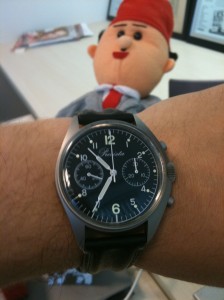 This watch also uses the Seagull (ex-Venus) manual-wind, column-wheel chronograph movement, but it is British. The Precista PRS-5 is a contemporary reissue of a classic military chronograph made for British forces in the 1970s. Originals used a Valjoux 7734 movement and were made by Hamilton, Breitling, CWC and Newmark as well as the original Precista. The Precista brand is one of a number of historic brands bought up and revived by Sheffield-based Eddie Platts with his Timefactors company (http://www.timefactors.com/). The first reissued Precista chronos used the Russian Poljot 3133 movement (itself based on dies from the V7734 sold to the Russians by the Swiss), but this second batch uses the Chinese Seagull. Either way, it’s a very attractive watch, with a thick, satin-finished case and domed acrylic crystal.
This watch also uses the Seagull (ex-Venus) manual-wind, column-wheel chronograph movement, but it is British. The Precista PRS-5 is a contemporary reissue of a classic military chronograph made for British forces in the 1970s. Originals used a Valjoux 7734 movement and were made by Hamilton, Breitling, CWC and Newmark as well as the original Precista. The Precista brand is one of a number of historic brands bought up and revived by Sheffield-based Eddie Platts with his Timefactors company (http://www.timefactors.com/). The first reissued Precista chronos used the Russian Poljot 3133 movement (itself based on dies from the V7734 sold to the Russians by the Swiss), but this second batch uses the Chinese Seagull. Either way, it’s a very attractive watch, with a thick, satin-finished case and domed acrylic crystal.
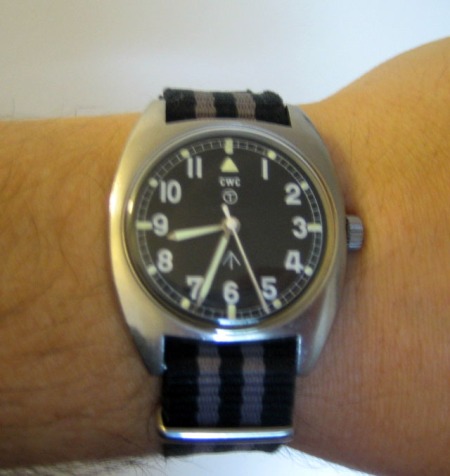 From reissues to the real deal: this is a CWC G10, issued to someone in the British army in 1977. Simple, robust, highly legible: an archetypal military watch.
From reissues to the real deal: this is a CWC G10, issued to someone in the British army in 1977. Simple, robust, highly legible: an archetypal military watch.
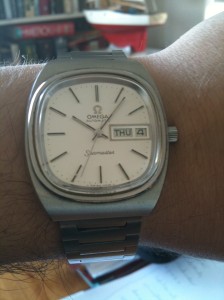 This Omega Seamaster cal.1020, known as a ‘TV’ model for pretty obvious reasons, dates from about 1975. My partner Kathy found it NOS from a dealer in Hong Kong and bought it for me a few years back. Automatic, day/date, matching bracelet.
This Omega Seamaster cal.1020, known as a ‘TV’ model for pretty obvious reasons, dates from about 1975. My partner Kathy found it NOS from a dealer in Hong Kong and bought it for me a few years back. Automatic, day/date, matching bracelet.
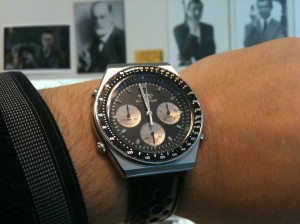 I don’t usually go for quartz watches, but I made an exception for this Seiko, a 7a27 chronograph from 1983. With its very high-quality, 15-jewelled movement, this is a mechanical watch in all but its power source. A version of this watch was issued to the RAF and is highly collectible: this civilian version is still somewhat rare but was an inexpensive buy on eBay.
I don’t usually go for quartz watches, but I made an exception for this Seiko, a 7a27 chronograph from 1983. With its very high-quality, 15-jewelled movement, this is a mechanical watch in all but its power source. A version of this watch was issued to the RAF and is highly collectible: this civilian version is still somewhat rare but was an inexpensive buy on eBay.
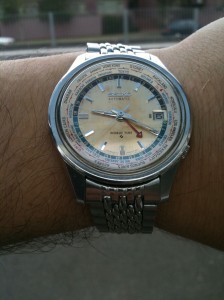 Another Seiko, this time a 1968 World Time (cal 6117). The dial was originally silver-white but has aged (pretty uniformly) to an attractive gold. The red 24-hour hand is matched with an inner bezel showing world cities. Oddly, this watch has an error: it shows GMT as a separate indicator, with London sharing a timezone with Paris and Rome — London and mainland Europe are always an hour apart. This error was corrected on later models.
Another Seiko, this time a 1968 World Time (cal 6117). The dial was originally silver-white but has aged (pretty uniformly) to an attractive gold. The red 24-hour hand is matched with an inner bezel showing world cities. Oddly, this watch has an error: it shows GMT as a separate indicator, with London sharing a timezone with Paris and Rome — London and mainland Europe are always an hour apart. This error was corrected on later models.
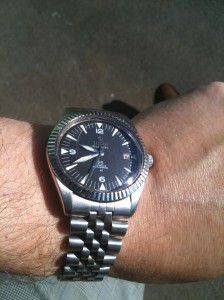 Last one for now: this is a Titoni Airmaster, probably dating from the late 1960s or early 70s. It has an ETA automatic movement and the design is an interesting mix of Rolex/Tudor (Oysterdate) and Omega (Railmaster) styling cues. For its era it’s quite big: 39 or 40mm. Inexpensive to buy, and runs well: although the movement is somewhat loose in the case and it is low on power, running accurately when worn but stopping pretty soon after its taken off the wrist.
Last one for now: this is a Titoni Airmaster, probably dating from the late 1960s or early 70s. It has an ETA automatic movement and the design is an interesting mix of Rolex/Tudor (Oysterdate) and Omega (Railmaster) styling cues. For its era it’s quite big: 39 or 40mm. Inexpensive to buy, and runs well: although the movement is somewhat loose in the case and it is low on power, running accurately when worn but stopping pretty soon after its taken off the wrist.



 Posted by timswatches
Posted by timswatches 


